Reasons You Shouldn't Flush Cat Poop Down Your Toilet - Preserve Your Plumbing System
Reasons You Shouldn't Flush Cat Poop Down Your Toilet - Preserve Your Plumbing System
Blog Article
We have encountered this article involving Can You Flush Cat Poo or Litter Down the Toilet? directly below on the web and reckoned it made perfect sense to write about it with you on my blog.

Introduction
As feline owners, it's important to bear in mind how we deal with our feline friends' waste. While it might seem convenient to flush feline poop down the bathroom, this technique can have destructive consequences for both the environment and human health.
Alternatives to Flushing
Fortunately, there are safer and extra liable means to deal with cat poop. Think about the adhering to alternatives:
1. Scoop and Dispose in Trash
The most typical technique of disposing of cat poop is to scoop it into a naturally degradable bag and throw it in the trash. Be sure to use a specialized clutter inside story and get rid of the waste quickly.
2. Use Biodegradable Litter
Go with eco-friendly feline litter made from materials such as corn or wheat. These clutters are environmentally friendly and can be safely taken care of in the trash.
3. Bury in the Yard
If you have a lawn, consider burying pet cat waste in a designated location far from vegetable gardens and water sources. Make certain to dig deep sufficient to stop contamination of groundwater.
4. Install a Pet Waste Disposal System
Purchase a pet dog waste disposal system particularly made for cat waste. These systems use enzymes to break down the waste, minimizing smell and ecological influence.
Health and wellness Risks
In addition to ecological issues, flushing feline waste can additionally posture health and wellness dangers to human beings. Pet cat feces might include Toxoplasma gondii, a parasite that can cause toxoplasmosis-- a potentially serious ailment, specifically for pregnant ladies and people with damaged body immune systems.
Environmental Impact
Flushing cat poop introduces harmful microorganisms and bloodsuckers into the water supply, positioning a significant danger to aquatic communities. These contaminants can adversely affect aquatic life and compromise water high quality.
Verdict
Responsible animal possession expands past offering food and sanctuary-- it also involves appropriate waste monitoring. By avoiding flushing pet cat poop down the bathroom and choosing different disposal techniques, we can minimize our ecological footprint and secure human wellness.
Why Can’t I Flush Cat Poop?
It Spreads a Parasite
Cats are frequently infected with a parasite called toxoplasma gondii. The parasite causes an infection called toxoplasmosis. It is usually harmless to cats. The parasite only uses cat poop as a host for its eggs. Otherwise, the cat’s immune system usually keeps the infection at low enough levels to maintain its own health. But it does not stop the develop of eggs. These eggs are tiny and surprisingly tough. They may survive for a year before they begin to grow. But that’s the problem.
Our wastewater system is not designed to deal with toxoplasmosis eggs. Instead, most eggs will flush from your toilet into sewers and wastewater management plants. After the sewage is treated for many other harmful things in it, it is typically released into local rivers, lakes, or oceans. Here, the toxoplasmosis eggs can find new hosts, including starfish, crabs, otters, and many other wildlife. For many, this is a significant risk to their health. Toxoplasmosis can also end up infecting water sources that are important for agriculture, which means our deer, pigs, and sheep can get infected too.
Is There Risk to Humans?
There can be a risk to human life from flushing cat poop down the toilet. If you do so, the parasites from your cat’s poop can end up in shellfish, game animals, or livestock. If this meat is then served raw or undercooked, the people who eat it can get sick.
In fact, according to the CDC, 40 million people in the United States are infected with toxoplasma gondii. They get it from exposure to infected seafood, or from some kind of cat poop contamination, like drinking from a stream that is contaminated or touching anything that has come into contact with cat poop. That includes just cleaning a cat litter box.
Most people who get infected with these parasites will not develop any symptoms. However, for pregnant women or for those with compromised immune systems, the parasite can cause severe health problems.
How to Handle Cat Poop
The best way to handle cat poop is actually to clean the box more often. The eggs that the parasite sheds will not become active until one to five days after the cat poops. That means that if you clean daily, you’re much less likely to come into direct contact with infectious eggs.
That said, always dispose of cat poop in the garbage and not down the toilet. Wash your hands before and after you clean the litter box, and bring the bag of poop right outside to your garbage bins.
https://trenchlesssolutionsusa.com/why-cant-i-flush-cat-poop/

We had been guided to that report on Can You Flush Cat Poo or Litter Down the Toilet? from someone on our other site. You should take a moment to distribute this entry if you enjoyed it. Thank you for taking the time to read it.
Click Report this page